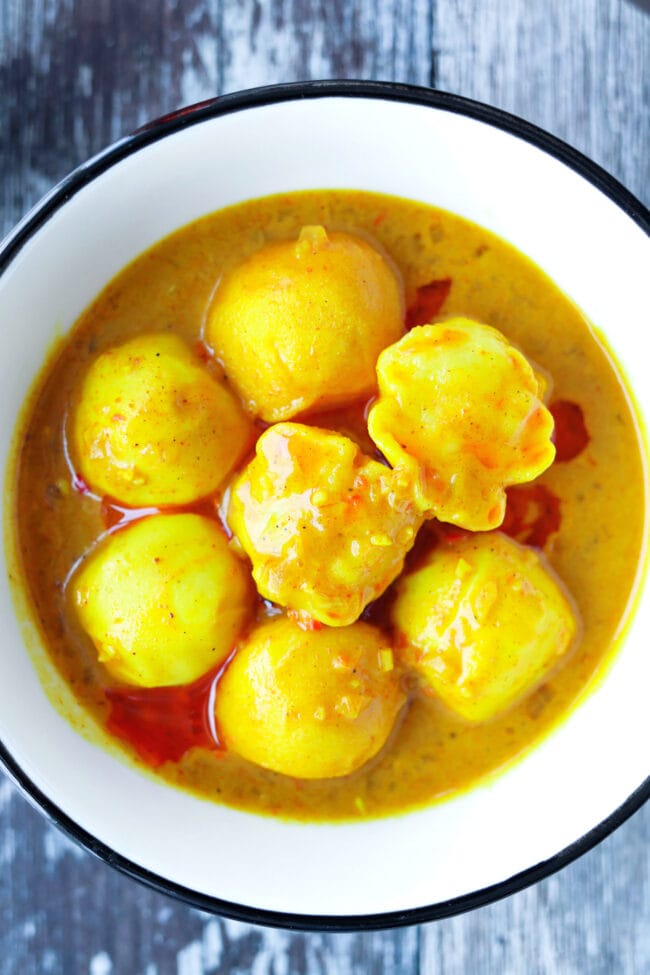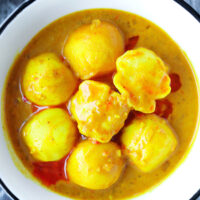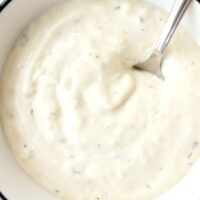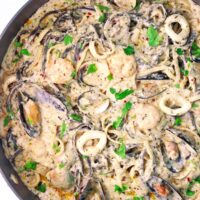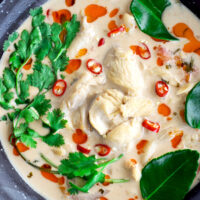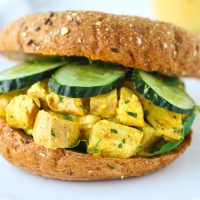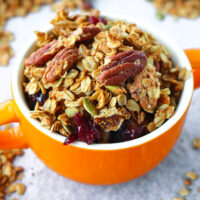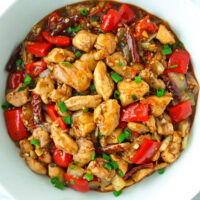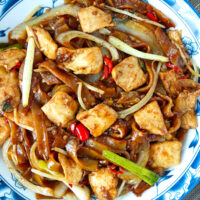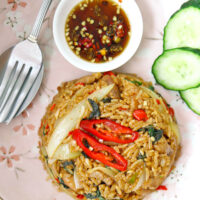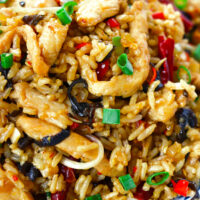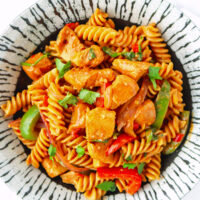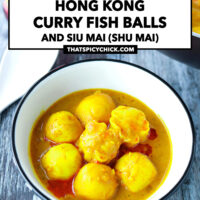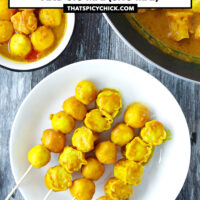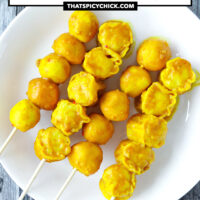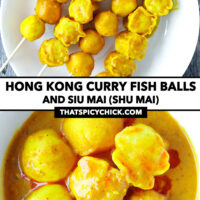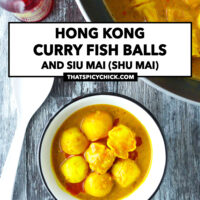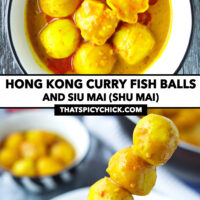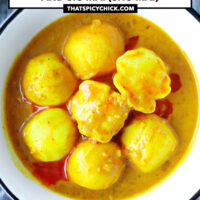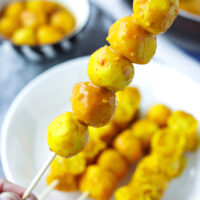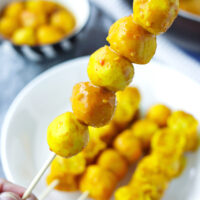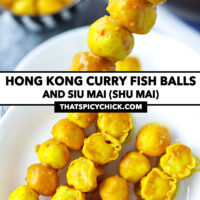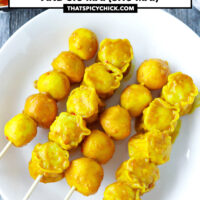Hong Kong Curry Fish Balls
This post contains affiliate links.
Hong Kong Curry Fish Balls is a classic street food snack that boasts a delicious, spicy and fragrant curry sauce! It’s easy to make, and can be enjoyed street food style on wooden skewers, in a bowl drizzled with plenty of chili oil, or over steamed rice or noodles!
Friends, I am super-duper and incredibly excited to be sharing my Hong Kong Curry Fish Balls (with shu mai) recipe today! 🤩 😍
If you’ve ever been to Hong Kong, you’ve most definitely spotted street food vendors with their carts of fish balls in a delicious curry sauce. It’s the iconic street food snack of the city, and beloved by locals and residents, including myself!
The wonderfully chewy and bouncy fish balls are simmered in a delicious curry sauce – every vendor has their own unique recipe for the sauce. They’re then sold on wooden skewers or in a styrofoam bowl, and topped off by the customer or vendor with soy sauce, chili oil, and/or chili paste.
Similarly, the street food version of shu mai (fish dumplings) are steamed and sold on wooden skewers, then drizzled with condiments too. Both of these snacks are then usually gobbled up on the streets in under 5 minutes!
From all of the delicious street food Hong Kong has to offer, these two are my absolute FAVORITE and give me so much joy! ❤️ Hence, I decided to create my own recipe for Hong Kong Curry Fish Balls to share with you all so that YOU can experience the delicious and MAGICAL experience too! 🤗
A note: Although shu mai is not traditionally simmered in a curry sauce, I’ve discovered that they too taste fabulous in the spicy, thick and fragrant sauce after being steamed first. I insist that you try it this style, because I think you’re going to love it as much as I do!
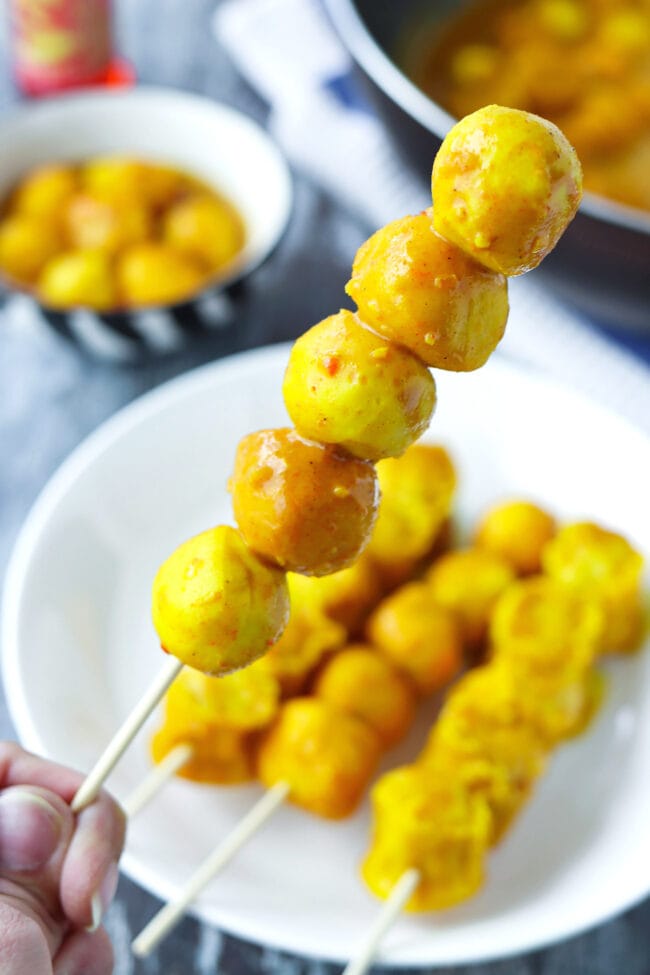
Why This Recipe Works
- Quick and easy. Everything comes together in under 30 minutes thanks to using store-bought fish balls and shu mai.
- Hong Kong Curry Powder. Using a Hong Kong Curry powder with flavorful Chinese spices makes the sauce wonderfully fragrant, hot, and spicy!
- Amazing texture! The wonderful texture of the chewy and bouncy fish balls and the soft and bouncy shu mai is irresistible. It’s truly a joyful experience in your mouth!
- DELICIOUS!! As a Hong Kong resident, I can’t get enough of curry fish balls and shu mai. I think you’re going to love all the delicious flavors and textures of this yummy street food snack too! 😋
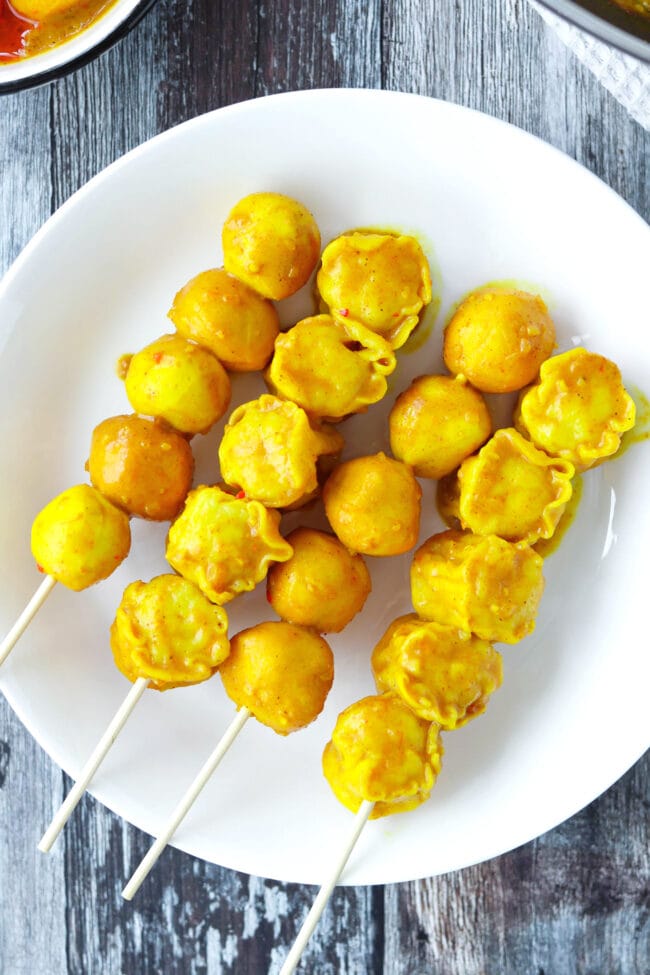
Ingredients Notes
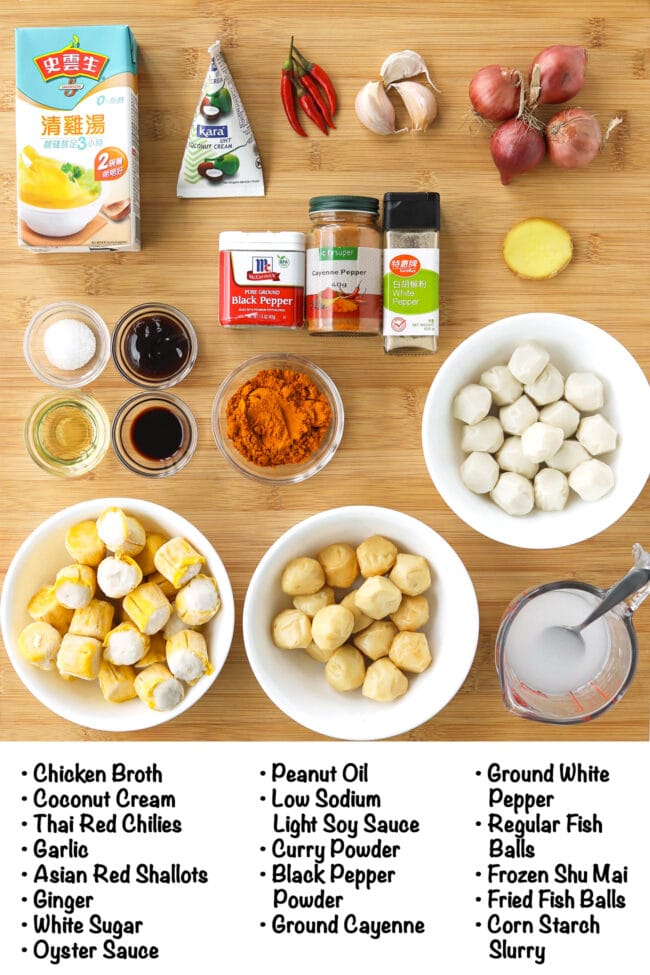
- Regular Fish Balls (non-fried): Chinese fish balls are made of fish meat, salt, either potato or corn starch, and sometimes other seasonings. They have a wonderful chewy and bouncy texture. They should be available in packages in the fridge or freezer section of Asian supermarkets. If using frozen, you don’t need to thaw them as they will be simmered long enough in the sauce to become tender.
- Fried Fish Balls: Ditto the above, but these ones are deep fried to give the fish ball a thin brown crust. They are slightly chewier and firmer than their non-fried counterparts, and have an extra layer of texture. I used both regular and non-fried fish balls in this recipe to enjoy the best of both worlds. I recommend that you do so too if you have haven’t tried fish balls before. It’ll allow you to try both types, and then in the future you can use both or whichever type you prefer more.
- Frozen Fish Shu Mai (siu mai/shao mai): These are a type of fish dumpling which are commonly served as a dim sum snack in Hong Kong. The dumpling wrapper is yellow in color, and the color comes from eggs used to make the wrappers. However, these days food coloring is often used instead to give the wrappers their signature yellow tint. Shu mai can also be made with beef, pork, shrimp, lobster, mushrooms, or a combination of any of these. The fish shu mai I used in this recipe are made from fish paste, and they are deliciously soft and bouncy! Look for frozen shu mai in the freezer section of an Asian supermarket.
- Peanut Oil: Or use any neutral flavored oil such as canola or vegetable oil.
- Asian Red Shallots: Substitute with red onion if unavailable.
- Thai Red Chilies: I used a few small hot red Bird’s Eye chilies to give the curry sauce a good level of heat. Use less or omit for a milder flavor.
- Curry Powder: I used a Hong Kong curry powder from the Koon Yick Wah Kee Factory brand. It’s made with chili powder, turmeric, star anise, Chinese cinnamon (cassia bark), dried parsley, ginger spice, Chinese prickly ash, and some other Chinese spices such as cao guo (Chinese black cardamom), yigui, and guhui. I highly recommend it as the flavor is sensational, and makes the curry sauce incredibly fragrant! However, if you don’t have access to this particular curry powder, substitute with another spicy curry powder such as Madras curry powder. It won’t taste the same, but will still be tasty!
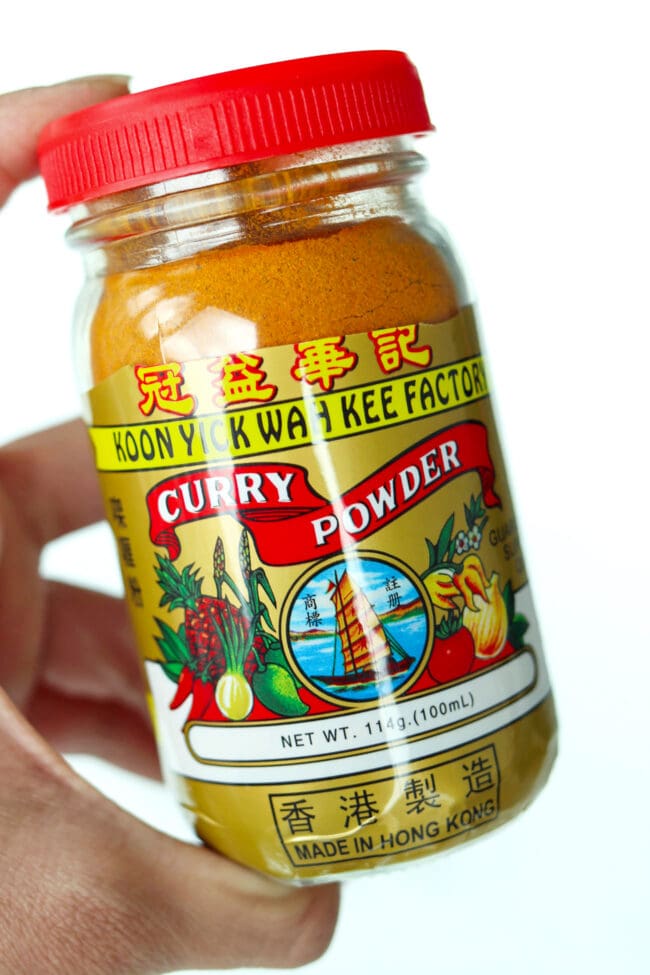
- Chicken Broth: I used an Asian style store-bought clear chicken broth. If using a low sodium chicken broth, add kosher salt or fine sea salt to taste.
- Coconut Cream: To thicken the curry sauce, and also add a hint of coconut flavor. You can use full-fat coconut milk if you prefer, but note that the sauce won’t be as rich and velvety.
- Oyster Sauce: This is an Asian pantry staple sauce that is thick and viscous in texture, and salty-sweet in flavor. Contrary to what one might think, it does not taste strongly of oysters. It helps to season the curry sauce and adds umami notes.
- Corn Starch Slurry: This will help thicken the curry sauce.
- Chili Oil: For serving. I LOVE to drizzle pure Chinese chili oil (without seeds or flakes) over my curry fish balls and shu mai. The street food vendors I frequent here in Hong Kong usually hand me the bottle of pure chili oil to squeeze as much as I want over my curry fish balls and shu mai bowl! However, you could also enjoy them with a Chinese chili oil that has seeds and flakes such as Lao Gan Ma Spicy Chili Crisp Sauce, or an Asian style chili sauce if you prefer.
Full ingredient list and amounts are in the recipe card below.
How to Make Hong Kong Curry Fish Balls
1. Steam the shu mai. Set up an aluminum, stainless steel, or a wok and lid steamer. Steam the frozen shu mai according to package instructions – usually about 10 minutes steaming time.
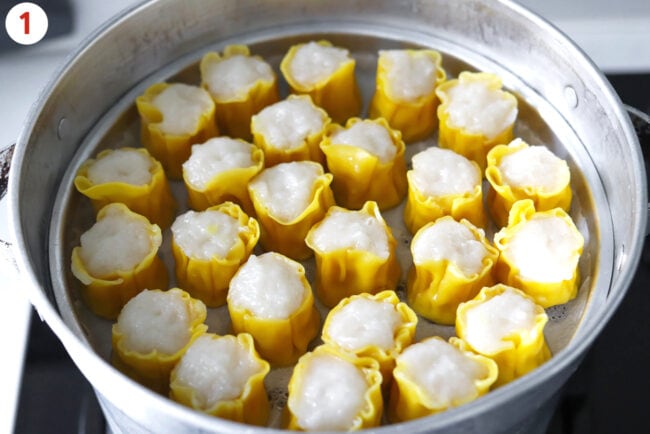
2. Sauté the aromatics. Meanwhile, heat peanut oil in a large wok or deep heavy bottomed frying pan. Add the shallots and sauté for a few minutes until softened. Then add the garlic, ginger, and red chilies and sauté for a few seconds until fragrant.
3. Stir in the curry powder. Sauté until combined well and fragrant.
4. Build the sauce. Pour in the chicken broth and coconut cream, mix well to combine. Then season with the soy sauce, oyster sauce, and all of the spices & seasonings. Stir well to combine.
5. Add the fish balls. Stir until coated well in the sauce.
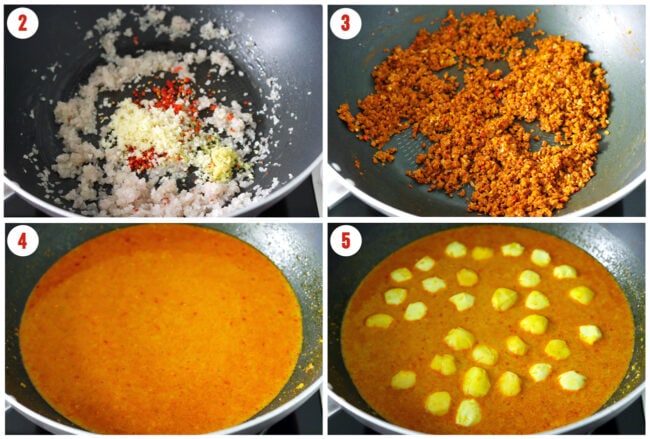
6. Simmer: Simmer uncovered for a few minutes, until the fish balls have heated through and the curry sauce has slightly thickened. Then use tongs to add the steamed fish shu mai, one by one, and stir to coat in the sauce.
7. Stir in the corn starch slurry. Simmer for a minute or so, until the sauce has thickened. Switch off the heat.
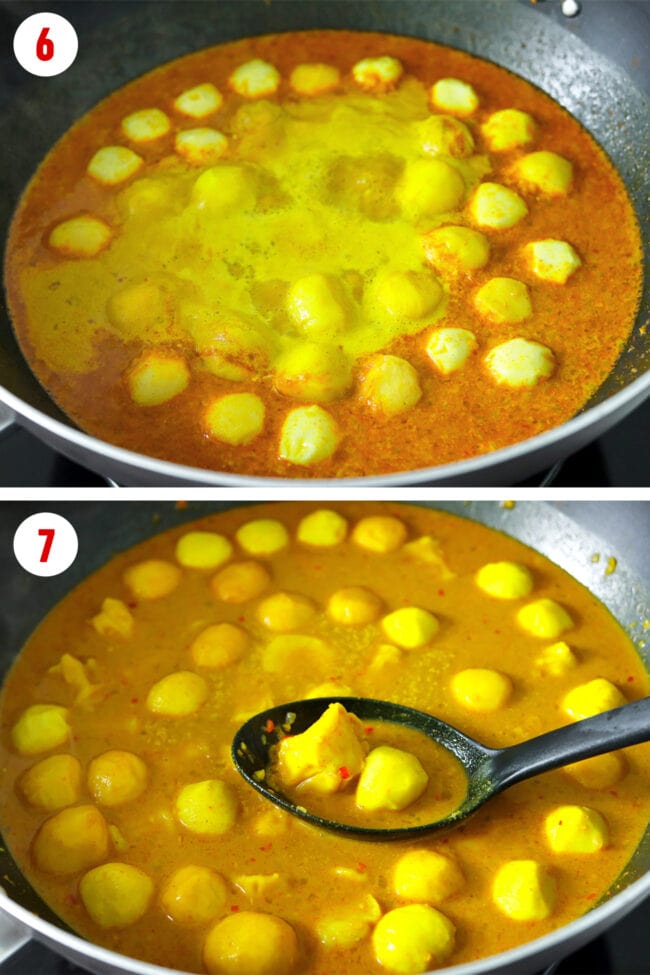
8. Serve! You can enjoy the curry fish balls and shu mai in bowls with plenty of chili oil drizzled on top.
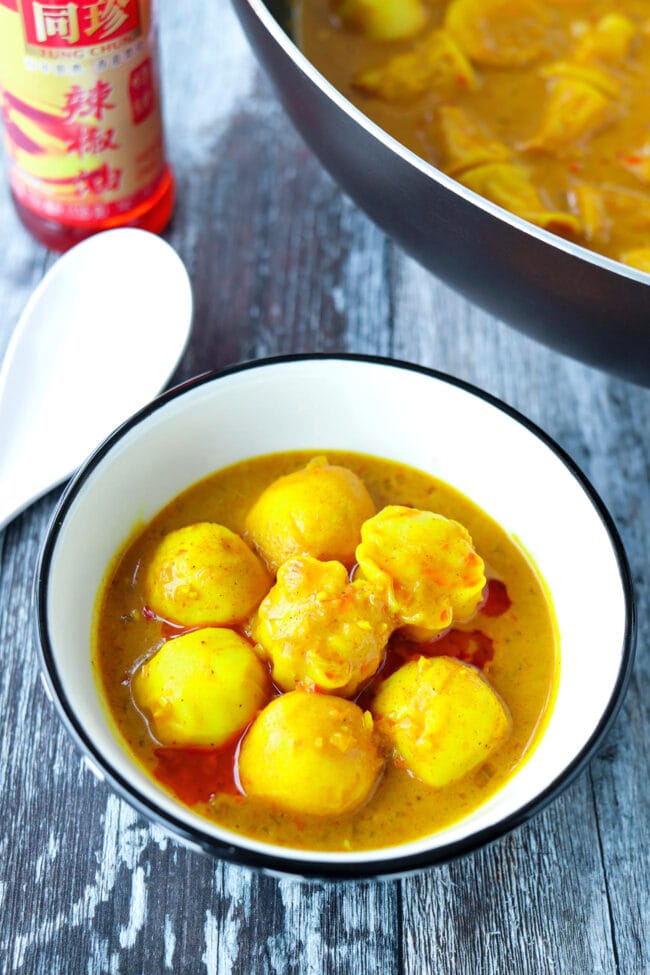
Or thread them onto wooden skewers and enjoy them Hong Kong street food style!

Alternatively, enjoy it as a meal and serve over steamed rice or toss with cooked noodles such as thick rice vermicelli. Both are great options for soaking up all that luscious curry sauce!
Full detailed instructions are in the recipe card below.
Cook’s Tips
- Don’t simmer for too long. The fish balls are already pre-cooked so you don’t want to overcook them. They’ll become too hard and rubbery instead of deliciously tender and chewy. Ten minutes is enough time if using non-frozen fish balls, and 10-15 minutes is enough if using frozen fish balls.
- Adjust salt to taste. If you’re using a low sodium chicken broth or stock, add salt to taste to season the curry sauce.
- Use less curry powder depending on your heat level preference. I use three tablespoons to give the sauce a nice and fragrant spices-infused kick. But use two tablespoons if you prefer a milder flavored curry sauce. Keep in mind that different curry powders will have varying heat levels. It’s always best to adjust the amount you use based on your knowledge of the heat level and your personal preference.
- Use fresh or frozen shu mai. Don’t use the ones that come in thick plastic packages that need to be boiled all at once with the package still on. After cooking, you’d need to cut the package open and serve immediately. It’s best to use fresh (if you have access to them), or frozen shu mai so that you can place the bag with the pieces you don’t use back in the freezer.

FAQs
Hong Kong style fish balls are made of cheap fish meat (mackerel, eel, and grey mullet are common choices) that is turned into a fish paste by either pounding, grinding, or shredding. The paste is combined with potato or corn starch and salt, and may include flavorings such as onion, chicken flavor powder, pepper powder, sugar, and sesame oil.
Look for the fish balls in the fridge or freezer section of an Asian supermarket and the frozen shu mai in the freezer section. In Hong Kong, they are available in supermarkets but also at stalls in wet markets.
After adding the shu mai to the sauce, it’s best to consume immediately on the same day or the shu mai wrappers will break down in the sauce and the fish meat will harden if stored in the fridge. Microwaving won’t necessarily make the shu mai tender again. However, if you add just the fish balls to the sauce, you can store for up 3-5 days in a sealed airtight container in the fridge. Reheat either in a pot on the stovetop over medium-high heat, or in the microwave on high for 1-2 minutes, stirring once in between, until hot throughout. If not consuming everything immediately, I recommend steaming only the quantity of shu mai that will be consumed on the day of eating. You can steam more as needed in the days to follow and drizzle any warmed up leftover curry sauce on top instead.
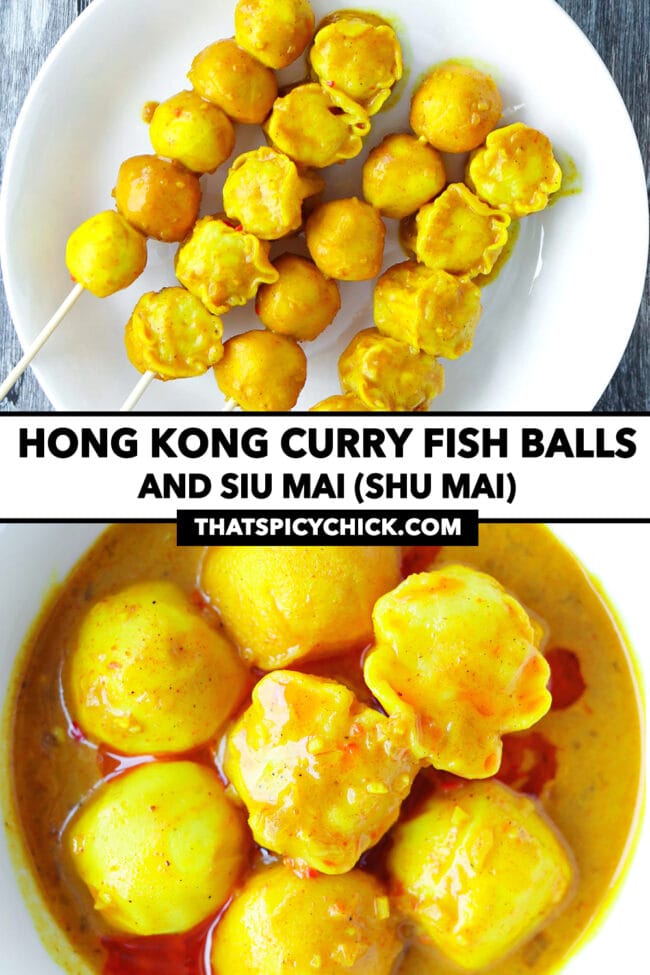
More Appetizers & Snacks
- Spicy Thai Basil Wontons
- Spicy Prawn Toast (with Everything Bagel Seasoning!)
- Baked Spicy Chicken Meatballs
- Or browse the entire Appetizers recipe collection.
More Curry Recipes
- Spicy Curry Laksa
- Japanese Pork Belly Curry
- Choo Chee Salmon Curry
- Peanut Butter Chicken Curry
- Thai Panang Chicken Curry
- Or browse the entire Curries & Stews recipe collection.
MADE THIS RECIPE? If you make this recipe, leave a comment below and let me know how you liked it! Take a photo and tag it with @thatspicychick on Instagram and hashtag it #thatspicychick and I’ll be sure to share your masterpiece!
STAY CONNECTED! You can also follow me on Pinterest, Facebook or Instagram. Sign up for my email list to get my latest recipe in your inbox weekly!
PrintHong Kong Curry Fish Balls
Hong Kong Curry Fish Balls is a classic street food snack that boasts a delicious, spicy and fragrant curry sauce! Enjoy them on wooden skewers, in a bowl drizzled with plenty of chili oil, or over steamed rice or noodles!
- Prep Time: 8
- Cook Time: 20
- Total Time: 28 minutes
- Yield: 6 1x
- Category: Appetizer
- Method: Simmer
- Cuisine: Cantonese
Ingredients
- 170 grams / 6 ounces (1 pack) Fried Fish Balls
- 170 grams / 6 ounces (1 pack) Fish Balls (regular/non-fried)
- 340 grams / 12 ounces frozen Fish Shu Mai
- 2 TBLS Peanut Oil (or canola or vegetable oil)
- 4 Asian Red Shallots (or ¼ medium red onion) – finely minced
- 3 Garlic cloves – finely minced
- 1 TBLS minced Ginger
- 2–4 Thai Red Chilies (I used Bird’s Eye, but any hot red chilies will work), to taste – finely chopped
- 3 TBLS Curry Powder (see notes*)
- 500ml / 2 cups Chicken Broth
- 65ml / 2.1 fluid ounces Coconut Cream
- 1 TSP Low Sodium Light Soy Sauce
- 1 TBLS Oyster Sauce
- 1 TSP White Sugar
- ¼ TSP Ground Cayenne (or chili powder), to taste
- 1/8 TSP Black Pepper Powder
- ¼ TSP ground White Pepper
- 1 TBLS Corn Starch + ½ cup Water – mixed together make a slurry
- To Serve: Pure Chinese Chili Oil (either with or without seeds/flakes), or chili paste
Instructions
- Prepare the fresh ingredients: Place the fried and regular fish balls in a fine mesh strainer and rinse under cold water from the sink, then set aside. Prepare/chop the Asian red shallots, garlic, ginger, and Thai red chilies, as indicated in the ‘Ingredients’ section.
- Steam the shu mai: Set up an aluminum, stainless steel, or a wok and lid steamer (see notes)*. Steam the frozen shu mai according to package instructions – usually about 10 minutes steaming time.
- Sauté the aromatics: Meanwhile, heat 2 tablespoons of peanut oil in a large wok or deep heavy bottomed frying pan over medium-high heat. Once hot, add the shallots and sauté for 3-5 minutes, until softened and just starting to brown. Add the garlic, ginger, and red chilies and sauté for 30-40 seconds until fragrant.
- Stir in the curry powder: Add the curry powder and sauté to combine for minute until fragrant.
- Build the sauce: Pour in the chicken broth and coconut cream, mix well to combine. Then add the low sodium light soy sauce, oyster sauce, white sugar, ground cayenne, black pepper powder, and ground white pepper. Stir well to combine.
- Add the fish balls and shu mai: Add the fish balls and stir until coated well in the sauce. Simmer uncovered for 10 minutes (or 10-15 minutes if using frozen fish balls), until the fish balls have heated through and the curry sauce has slightly thickened. Then using tongs, add the steamed fish shu mai one by one, and stir to coat the sauce.
- Stir in the corn starch slurry: Mix the corn starch and water in a measuring cup until combined well. Then pour the slurry into the wok and stir to combine. Simmer for 1-2 minutes, until the sauce has thickened. Then switch off the heat.
- To Serve: Divide the fish balls, shu mai, and sauce evenly into bowls. Serve with plenty of pure Chinese chili oil poured on top or chili paste if desired and enjoy! Alternatively, thread the fish balls and shu mai onto wooden skewers and enjoy them street food style!
Notes
- Fish balls: I used non-frozen fish balls, which can be found in packages in the fridge section of the supermarket. You can also use frozen fish balls without thawing first. They will be simmered long enough in the sauce to become tender again. Using fried or regular fish balls is a matter of preference. I’ve called for both in this recipe, which is a good way to try them out it’s your first time eating them. Then in the future you can use both types or whichever one you prefer more.
- Frozen Fish Shu Mai: These are small fish dumplings that can be found in the freezer section on an Asian supermarket. You can use additional fish balls and skip the shu mai if you wish, but they do taste fantastic with the curry sauce too!
- Curry Powder: I used a Hong Kong curry powder from the Koon Yick Wah Kee Factory brand. It’s made with chili powder, turmeric, star anise, Chinese cinnamon (cassia bark), dried parsley, ginger spice, Chinese prickly ash, and some other Chinese spices such as cao guo (Chinese black cardamom), yigui, and guhui. I highly recommend it as the flavor is sensational, and makes the curry sauce incredibly fragrant! If you don’t have access to this particular curry powder, substitute with another spicy curry powder such as Madras curry powder. The flavor of the sauce will be different, but it will still taste delicious.
- How to set up a steamer: See this post for how to set up a wok and lid steamer, a stainless steel steamer, or bamboo steamer.
- To serve as a meal: In addition to eating on skewers or in a bowl topped with chili oil, you can also serve the curry fish balls and shu mai as a meal over steamed rice or cooked noodles such as thick rice vermicelli.
- How long will it keep? After adding the shu mai to the sauce, it’s best to consume immediately on the same day or the shu mai wrappers will break down in the sauce and the fish meat will harden if stored in the fridge. Microwaving won’t necessarily make the shu mai tender again. However, if you add just the fish balls to the sauce, you can store for up 3-5 days in a sealed airtight container in the fridge. Reheat either in a pot on the stovetop over medium-high heat, or in the microwave on high for 1-2 minutes, stirring once in between, until hot throughout. If not consuming everything immediately, I recommend steaming only the quantity of shu mai that will be consumed on the day of eating. You can steam more as needed in the days to follow and drizzle any warmed up leftover curry sauce on top instead.
Nutrition
- Serving Size: 1 serving
- Calories: 311
- Sugar: 5.3g
- Sodium: 1491.1mg
- Fat: 13.4g
- Saturated Fat: 2.5g
- Unsaturated Fat: 4g
- Trans Fat: 0g
- Carbohydrates: 31.6g
- Fiber: 2.3g
- Protein: 11.9g
- Cholesterol: 0mg
This post may contain affiliate links. We are a part of the Amazon Services LLC Associates Program, an affiliate advertising program designed to provide a means for us to earn a small commission (at no extra cost to you) by linking to Amazon.com and affiliated sites. The nutritional information provided is approximate and can vary based on several factors. It should only be used as a general guideline. For more information, please see our Disclosure.

